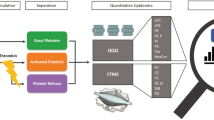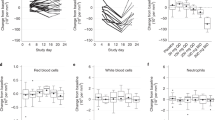Abstract
The goals of this investigation were, first, to develop a chemical strategy to identify and quantitate the mass of fatty acid which is covalently bound to proteins by thioester linkage in unactivated platelets, and, second, to determine whether exogeneously added fatty acids can alter the fatty acid composition of thioester bound fatty acids. Studies with radio-labeled fatty acids cannot identify and quantitate the actual fatty acids bound to proteins because they permit analysis of only the radiolabeled fatty acids added and their metabolites. Therefore, in the absence of metabolic labeling by radiolabeled fatty acids, we isolated the thioester-linked fatty acids from platelet proteins using hydroxylamine at neutral pH to form fatty acid hydroxamates. The hydroxamates were subsequently converted to fatty acid methyl esters by acid methanolysis for quantitation by gas chromatography-mass spectrometry. Using platelet specimens from 14 subjects, 74% of the fatty acid recovered from the unactivated platelet proteins as thioester linked was palmitate. Importantly, however, 22% was stearic acid, and oleate was 4% of the total thioester bound fatty acid. There was minimal variability (2.6-fold at maximum) between the subjects in the amount of the thioester-linked palmitate and thioester-linked stearate. However, there was substantial variability (>100-fold at maximum) between subjects in the amount of thioester-linked oleate. We also demonstrated that incubation of platelets with exogenous fatty acids can alter the profile of fatty acids bound to platelet proteins by thioester linkages. Incubation of platelets with 100 µM palmitate for 3 h increased the amount of thioester-linked palmitate by up to 26%, and incubation of platelets with 100 µM stearate increased the amount of thioester-linked stearate up to 30%. In support of the observation that radiolabeled fatty acids other than palmitate were shown to be capable of binding to platelet proteins by thioester linkage, our results indicate that the fatty acids actually bound to unactivated platelet proteins include a significant amount of stearate, and variable amounts of oleate, as well as palmitate. In addition, the data show that palmitate and stearate can be increased, as a percentage of total protein-bound fatty acid, by incubation with exogenous palmitate and stearate, respectively.
Similar content being viewed by others
Abbreviations
- GC-MS:
-
gas chromatography—mass spectrometry
- GPI:
-
glycosylphosphatidylinositol
- FAME:
-
fatty acid methyl ester
- PGE1 :
-
prostaglandin E1
References
Casey, P.J. (1995) Protein Lipidation in Cell Signaling,Science 268, 221–225.
Milligan, G., Parenti, M., and Magee, A.I. (1995) The Dynamic Role of Palmitoylation in Signal Transduction,Trends Biochem. Sci. 20, 181–187.
Low, M.G. (1989) Glycosyl-Phosphatidylinositol: A Versatile Anchor for Cell Surface Proteins,FASEB J. 3, 1600–1608.
Low, M.G., and Saltiel, A.R. (1988) Structural and Functional Roles of Glycosyl-Phosphatidylinositol in Membranes,Science 239, 268–275.
Muszbek, L., and Laposata, M. (1993) Myristoylation of Proteins in Platelets Occurs Predominantly Through Thioester Linkages,J. Biol. Chem. 268, 8251–8255.
Muszbek, L., and Laposata, M. (1989) Covalent Modification of Platelet Proteins by Palmitate,Blood 74, 1339–1347.
Muszbek, L., and Laposata, M. (1993) Covalent Modification of Proteins by Arachidonate and Eicosapentaenoate in Platelets,J. Biol. Chem. 268, 18243–18248.
Masterson, W.J., Raper, J., Doering, T.L., Hart, G.W., and Englund, P.T. (1990) Fatty Acid Remodeling: A Novel Reaction Sequence in the Biosynthesis of Trypanosome Glycosyl Phosphatidylinositol Membrane Anchors,Cell 62, 73–80.
Kaufman, J.F., Krangel, M.S., and Strominger, I.L. (1984) Cysteines in the Transmembrane Region of Major Histocompatibility Complex Antigens are Fatty Acylatedvia Thioester Bonds,J. Biol. Chem. 259, 7230–7238.
Hennes, A.R., Awai, K., Hammerstrand, K., and Duboff, G.S. (1966) Carbon-14 in Carboxyl Carbon of Fatty Acids Formed by Platelets from Normal and Diabetic Subjects,Nature 210, 839–841
Wilcox, C.A., Hu, J.S., and Olson, N.E. (1987) Acylation of Proteins by Myristic Acid Occurs Cotranslationally,Science 238, 1275–1278
Buss, J.E., Solski, P.A., Schaeffer, J.P., MacDonald, M.J., and Der, C.J. (1989) Activation of the Cellular Proto-Oncogene Product p21 Ras by Addition of a Myristylation Signal,Science 243, 1600–1603.
Wedegaertner, P.B., Chu, D.H., Wilson, P.T., Levis, M.J., and Bourne, H.R. (1993) Palmitoylation is Required for Signaling Functions and Membrane Attachment of Gqα and Gsα,J. Biol. Chem. 268, 25001–25008.
O’Dowd, B.F., Hnatowich, M., Caron, M.G., Lefkowitz, R.J., and Bouvier, M. (1989) Palmitoylation of the Human β2-Adrenergic Receptor,J. Biol. Chem. 264, 7564–7569.
Zhang, F., Kamp, F., and Hamilton, J.A. (1996) Dissociation of Long and Very Long Chain Fatty Acids from Phospholipid Bilayers,Biochemistry 35, 16055–16060.
Fujimoto, T., Stroud, E., Whatley, R.E., Prescott, S.M., Muszbek, L., Laposata, M., and McEver, R.P. (1993) P-Selectin is Acylated with Palmitic Acid and Stearic Acid at Cysteine 766 Through a Thioester Linkage,J. Biol. Chem. 268, 11394–11400.
Zeng, F.Y., Kaphalia, B.S., Ansari, G.A.S., and Weigel, P.H. (1995) Fatty Acylation of the Rat Asialoglycoprotein Receptor,J. Biol. Chem. 270, 21382–21387.
Berthiaume, L., and Resh, M.D. (1995) Biochemical Characterization of a Palmitoyl Acyltransferase Activity that Palmitoylates Myristoylated Proteins,J. Biol. Chem. 270, 22399–22405.
Author information
Authors and Affiliations
Corresponding author
About this article
Cite this article
Muszbek, L., Haramura, G., Cluette-Brown, J.E. et al. The pool of fatty acids covalently bound to platelet proteins by thioester linkages can be altered by exogenously supplied fatty acids. Lipids 34 (Suppl 1), S331–S337 (1999). https://doi.org/10.1007/BF02562334
Issue Date:
DOI: https://doi.org/10.1007/BF02562334




